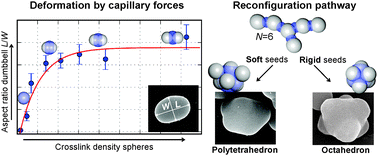当前位置:
X-MOL 学术
›
Soft Matter
›
论文详情
Our official English website, www.x-mol.net, welcomes your
feedback! (Note: you will need to create a separate account there.)
Complex patchy colloids shaped from deformable seed particles through capillary interactions†
Soft Matter ( IF 2.9 ) Pub Date : 2018-01-04 00:00:00 , DOI: 10.1039/c7sm02020a V. Meester 1, 2, 3, 4, 5 , D. J. Kraft 1, 2, 3, 4, 5
Soft Matter ( IF 2.9 ) Pub Date : 2018-01-04 00:00:00 , DOI: 10.1039/c7sm02020a V. Meester 1, 2, 3, 4, 5 , D. J. Kraft 1, 2, 3, 4, 5
Affiliation

|
We investigate the mechanisms underlying the reconfiguration of random aggregates of spheres through capillary interactions, the so-called “colloidal recycling” method, to fabricate a wide variety of patchy particles. We explore the influence of capillary forces on clusters of deformable seed particles by systematically varying the crosslink density of the spherical seeds. Spheres with a poorly crosslinked polymer network strongly deform due to capillary forces and merge into large spheres. With increasing crosslink density and therefore rigidity, the shape of the spheres is increasingly preserved during reconfiguration, yielding patchy particles of well-defined shape for up to five spheres. In particular, we find that the aspect ratio between the length and width of dumbbells, L/W, increases with the crosslink density (cd) as L/W = B − A·exp(−cd/C). For clusters consisting of more than five spheres, the particle deformability furthermore determines the patch arrangement of the resulting particles. The reconfiguration pathway of clusters of six densely or poorly crosslinked seeds leads to octahedral and polytetrahedral shaped patchy particles, respectively. For seven particles several geometries were obtained with a preference for pentagonal dipyramids by the rigid spheres, while the soft spheres do rarely arrive in these structures. Even larger clusters of over 15 particles form non-uniform often aspherical shapes. We discuss that the reconfiguration pathway is largely influenced by confinement and geometric constraints. The key factor which dominates during reconfiguration depends on the deformability of the spherical seed particles.
中文翻译:

复杂的斑片状胶体通过毛细管相互作用从可变形的种子颗粒中形成†
我们研究了通过毛细相互作用(所谓的“胶体回收”方法)来重新构造球形随机聚集体的机制,以制造各种各样的斑块状颗粒。我们通过系统地改变球形种子的交联密度来探索毛细作用力对可变形种子颗粒簇的影响。交联聚合物网络不良的球会由于毛细作用力而强烈变形,并合并成大球。随着交联密度的增加和刚性的提高,在重新配置过程中,球的形状越来越多地得到保留,从而产生了多达五个球的形状明确的斑块状颗粒。特别是,我们发现哑铃的长与宽之间的纵横比L / W随交联密度(cd)的增加而增加,因为L / W = B − A ·exp(-cd / C)。对于由五个以上球体组成的团簇,粒子的可变形性还决定了所得粒子的面片排列。六个密集或不良交联的种子簇的重构路径分别导致八面体和多四面体形状的斑片状颗粒。对于七个粒子,获得了几种几何形状,刚性球体优先选择五角双锥体,而软球体很少到达这些结构。甚至超过15个粒子的更大簇也形成不均匀的非球面形状。我们讨论了重构路径在很大程度上受约束和几何约束的影响。在重构过程中占主导地位的关键因素取决于球形种子粒子的可变形性。
更新日期:2018-01-04
中文翻译:

复杂的斑片状胶体通过毛细管相互作用从可变形的种子颗粒中形成†
我们研究了通过毛细相互作用(所谓的“胶体回收”方法)来重新构造球形随机聚集体的机制,以制造各种各样的斑块状颗粒。我们通过系统地改变球形种子的交联密度来探索毛细作用力对可变形种子颗粒簇的影响。交联聚合物网络不良的球会由于毛细作用力而强烈变形,并合并成大球。随着交联密度的增加和刚性的提高,在重新配置过程中,球的形状越来越多地得到保留,从而产生了多达五个球的形状明确的斑块状颗粒。特别是,我们发现哑铃的长与宽之间的纵横比L / W随交联密度(cd)的增加而增加,因为L / W = B − A ·exp(-cd / C)。对于由五个以上球体组成的团簇,粒子的可变形性还决定了所得粒子的面片排列。六个密集或不良交联的种子簇的重构路径分别导致八面体和多四面体形状的斑片状颗粒。对于七个粒子,获得了几种几何形状,刚性球体优先选择五角双锥体,而软球体很少到达这些结构。甚至超过15个粒子的更大簇也形成不均匀的非球面形状。我们讨论了重构路径在很大程度上受约束和几何约束的影响。在重构过程中占主导地位的关键因素取决于球形种子粒子的可变形性。











































 京公网安备 11010802027423号
京公网安备 11010802027423号